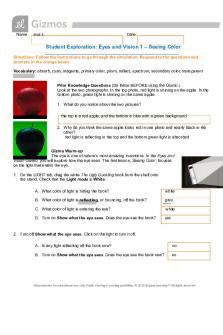Lab 2 - Lab # 2: Measurement of Light Intensity as a Function of Distance from a Light PDF

| Title | Lab 2 - Lab # 2: Measurement of Light Intensity as a Function of Distance from a Light |
|---|---|
| Course | General Physics: Mechanics, Heat and Sound |
| Institution | University of Pennsylvania |
| Pages | 2 |
| File Size | 117.9 KB |
| File Type | |
| Total Downloads | 52 |
| Total Views | 131 |
Summary
Lab # 2: Measurement of Light Intensity as a Function of Distance from a Light Source
Purpose: The purpose of this lab is to determine the relationship between light intensity and the distance between the source and detector also to understand how the shape of light source changes this ...
Description
Lab # 2: Measurement of Light Intensity as a Function of Distance from a Light Source Purpose: The purpose of this lab is to determine the relationship between light intensity and the distance between the source and detector also to understand how the shape of light source changes this relationship (using loggerPro). Expectations: Our expectations are to see that as distance increases that the intensity of light will decrease by the square of the distance.
The inverse square fit is less representative of the curve because it does not take into account background values. Thats why the new fit its able to better match the curve. As represented in the graph above. Red line: Light bulb Green line: LED lights When we measured the background these are the values we obtained: C= 11.8 lux, our curve fit gives us a C value of -23.33 lux for light bulb and 1055 lux for LED lights B=19.1 lux, our curve fit gives us a B value of .1226 lux for light bulb and -0.4694 lux for LED light 1. The data shows that as distance increases, the intensity of light decreases by the square of the distance. The function I=A/(x+B)^2 +C gives a better fit than the function I=A/x^2.
2. Our results are consistent with Gauss’s law. The shape of the graph of our best fit demonstrates that light intensity is inversely proportional with the value of distance squared. This is exactly what the Gauss’s law states.
Conclusion Apart from improper measurement and equipment inaccuracy, other possible sources of error include the light sensor and LoggerPro not working properly. Unaccounted background light could have impacted the data. The sensor also could not have been aligned properly with each light source. For the light bulb, our expectations matched our results because the data was best fit to the equation I=A/(x+B)^2 +C, which indicates that the intensity of the light decreased by the square of the distance. For the LED lights, however, the data did not match our expectations. The I=A/ (x+B)^2 +C line did not exactly match our data and, more importantly, the intensity of the light was constant up until a certain distance. Therefore, we conclude that the shape of the light does affect the relationship between light intensity and distance. Feedback We learned how to use logger pro and enjoyed working with our own data. We appreciated quantitatively analyzing the relationship between light intensity and distance in view of the physics concepts we learned in class. Furthermore, we also deepened our understanding of the different ways LED versus incandescent light bulbs operate....
Similar Free PDFs

Trajectory of a Beam of Light
- 3 Pages

Speed Of Light Lab Write Up
- 8 Pages

Light and Color (Lab #1)
- 3 Pages

Measurement lab report 2
- 2 Pages

Lab 2: Viscosity measurement
- 9 Pages

Lab report 2. Components of a Vector
- 10 Pages

Light Pollution Essay - Grade: A
- 2 Pages

Light 2 for star wars
- 3 Pages

Ray of Light - Apuntes 1
- 49 Pages

LAB 2 - Lab Report of 2nd lab
- 10 Pages
Popular Institutions
- Tinajero National High School - Annex
- Politeknik Caltex Riau
- Yokohama City University
- SGT University
- University of Al-Qadisiyah
- Divine Word College of Vigan
- Techniek College Rotterdam
- Universidade de Santiago
- Universiti Teknologi MARA Cawangan Johor Kampus Pasir Gudang
- Poltekkes Kemenkes Yogyakarta
- Baguio City National High School
- Colegio san marcos
- preparatoria uno
- Centro de Bachillerato Tecnológico Industrial y de Servicios No. 107
- Dalian Maritime University
- Quang Trung Secondary School
- Colegio Tecnológico en Informática
- Corporación Regional de Educación Superior
- Grupo CEDVA
- Dar Al Uloom University
- Centro de Estudios Preuniversitarios de la Universidad Nacional de Ingeniería
- 上智大学
- Aakash International School, Nuna Majara
- San Felipe Neri Catholic School
- Kang Chiao International School - New Taipei City
- Misamis Occidental National High School
- Institución Educativa Escuela Normal Juan Ladrilleros
- Kolehiyo ng Pantukan
- Batanes State College
- Instituto Continental
- Sekolah Menengah Kejuruan Kesehatan Kaltara (Tarakan)
- Colegio de La Inmaculada Concepcion - Cebu





